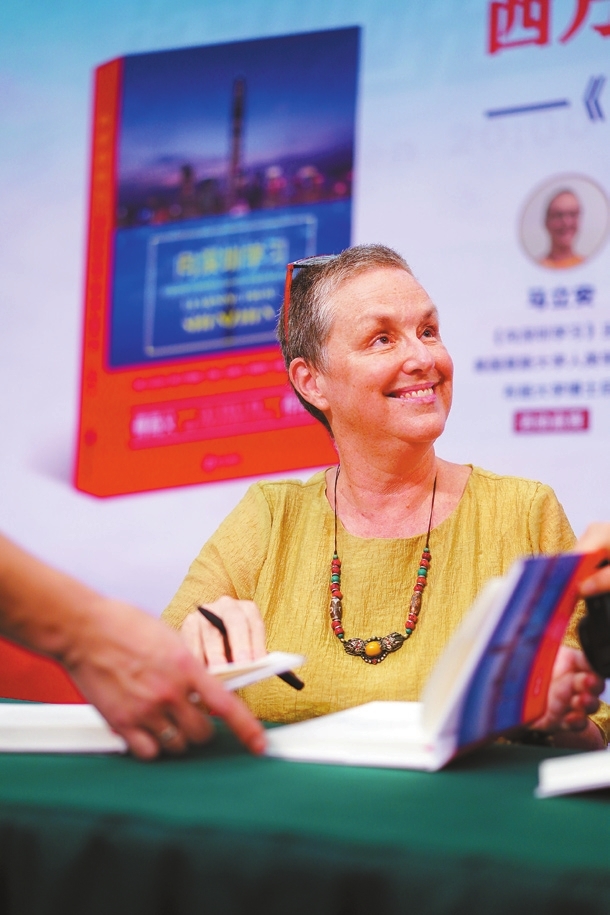

Tan Yifan cicitan2011@gmail.com A CHINESE translation of a book that depicts and analyzes the successes and achievements made by China’s “test field” of reform and opening-up policy — Shenzhen — is now available at mainland bookstores and on online platforms. The book, “Learning from Shenzhen — China’s Post-Mao Experiment from Special Zone to Model City,” co-edited by Mary Ann O’Donnell, a Shenzhen-based U.S. anthropologist, Winnie Wong, assistant professor of rhetoric and art history at the University of California, Berkeley, and Jonathan Bach, associate professor of international affairs and chairperson of the Global Studies Interdisciplinary Program at The New School in New York City, was published by The University of Chicago Press three years ago. The book, whose cover best reflects a Western stereotype of China — with red cover and golden characters — didn’t get much attention from Shenzheners at the time of publication mainly due to the language gap and its inaccessibility for mainland readers. As the city prepares to summarize on its past deeds and gains, the book caught the attention of local Haitian Publishing House. A publishing team was then formed and Wang Lidi, famed translator and associated dean of the school of Humanities and Social Science of The Chinese University of Hong Kong, Shenzhen, was invited to be the Chinese-version translator. “As one among the first batch of Chinese readers, I found the writings were quite appealing. It not only possesses academic value but also conveys humanistic care,” said Wang at Sunday’s book signing event. “It enriches my understanding of the city, which is inclusive and open.” With a rigorous academic attitude, while at the same time loyally reflecting authors’ writings, Wang also subtly adjusted words and phrases to appeal more to the literary tastes of Chinese readers. “I think the book shimmers with charms,” said Yin Changlong, chairman of Shenzhen Publishing Group, the holding company of Haitian. “The main narrator O’Donnell came to Shenzhen 20 years ago to observe the city as a ‘foreigner,’ but then became a part of it. She analyzes Shenzhen and associates its development with other international cities. She is not simply offering answers through cold materials (such as data), but blends in her own life experiences, which brings sentiment and empathy to readers.” Yin said he has kept contact with O’Donnell over the past 20 years and believed the book is meaningful for the research of urban development. “We all admit that Shenzhen represents the miracle of China’s past development. But there are few scholars who have studied the miracle, to tell us what has made Shenzhen a success. It wouldn’t be that objective if the study had been conducted by a Chinese scholar; thus, the publisher decided to issue a Chinese version, which would also be a gift to the city’s 40th birthday,” said Yin. Prefaced by Ezra F. Vogel, Henry Ford II Professor of the Social Sciences Emeritus at Harvard and writer of “Deng Xiaoping and the Transformation of China,” the book “details the progression of Shenzhen from experiment to official model” and how the local government intervenes in “microlevel social change, appropriating the city’s stunning economic successes into larger national political narratives.” Its title was inspired by the slogan “learning from Dazhai,” which was invented during the Mao Zedong era and the call upon American architects in the 1980s to learn from Las Vegas’ new model of architectural design and urban development. O’Donnell found that it’s interesting that the two countries somehow share inconspicuous similarities by setting up some kind of “models” during that period to drive the progress of society. She intended to find out if scholars and observers could accept Shenzhen as a model “for a new form of global Chinese capitalism run by single-party socialism” and even “promote its redeployment for economic and political change” internationally. To answer the questions, she divided Shenzhen’s development into three periods: the Experiments (1979-92), Exceptions (1992-2004) and Extensions (2004-present). In the book, writers study on the research of policy making, choices and decisions made by early political and government leaders, city planning and conflicts, the formation of “Shenzhen Spirit,” the value of “urbanized villages” and migrant workers, the relationship of urbanization and ruralization, licit and illicit, formal and informal, various “models” that were being set up, creative industries, the public health system, infrastructure and more. By studying from various aspects, the book “provides critical and multidisciplinary assessments of Shenzhen’s viability as a model of Chinese urbanization, situating both its successes and failures.” “I think the core of the book is about how people with different backgrounds and conditions interact and play their parts and make contributions when facing the same questions,” said O’Donnell. “They can discover the brilliance of common people and learn from each other and never exclude outsiders, which makes the city a warm, open place. It offers every one the opportunity and right to make trial and error.” | 
